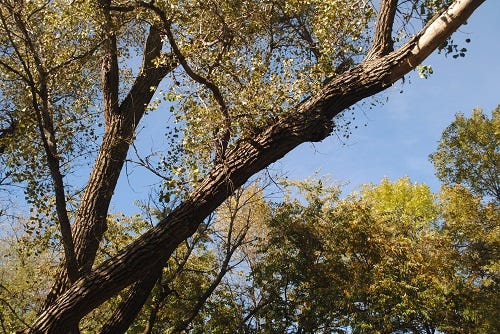
Since its designation in 1972, Eastern cottonwood has been our state tree. And Nebraska maintains the national champion cottonwood tree, located in Gage County. This mammoth tree measures 88 feet high, and has a diameter of 36 feet, 9 inches.
According to the Nebraska Forest Service, cottonwood, or Populus deltoides, is native across the state, but is usually found in native stands near rivers, streams and lakes. A fast grower, the cottonwood has been used for lumber, but also has conservation value by stabilizing stream banks and mitigating sedimentation in riparian areas and filter strip plantings. It is common to see old stand cottonwood trees encompassing historic farmsteads.

This past summer, I noticed that some of the century-old cottonwood trees around our farm had begun to prematurely drop leaves. Upon further investigation, I noticed that some of the leaves had browned and were dried up. When doing farmer interviews in September in the Sandhills in Wheeler County, a rancher asked me about the same thing. This was unusual, I thought, especially in an extremely wet summer.
While parts of Nebraska have experienced dry conditions this summer and may have early tree defoliation because of this scenario, it is unlikely where moisture has been plentiful. It certainly could have been insect damage, but it seems this becomes more of an issue in drought years.
One report I read from the University of Idaho says that some diseases can cause significant defoliation of cottonwood and poplar trees in wet years. At least three different fungi attack cottonwood and poplar trees with leaf spot and rust, causing early defoliation. Although this situation is most likely not necessarily detrimental to the long term health of older trees, it is curious and something to follow and investigate. Most likely we won’t know exactly what happened with some cottonwood trees this summer unless individual circumstances are checked out. Certainly, the right combination of environmental factors, perhaps too dry early, then excessive wet conditions going into fall, could also have caused the early browning and defoliation.
For farmers and ranchers who love trees, especially the state tree, the situation is probably nothing dire, but it would be something to monitor next season as the trees leaf out again. In other words, I have no idea what happened. If you are concerned about the long term health of your cottonwood trees or any farmstead trees, be sure to contact your NFS District Forester for more information.
Here is this month’s discussion question? Did your cottonwood trees defoliate early this season? And if they did, what were the environmental conditions around your place this season? You can leave your observations and comments here.
Have a Happy Halloween and be careful out there with all of the trick-or-treaters out and about.
About the Author(s)
You May Also Like






